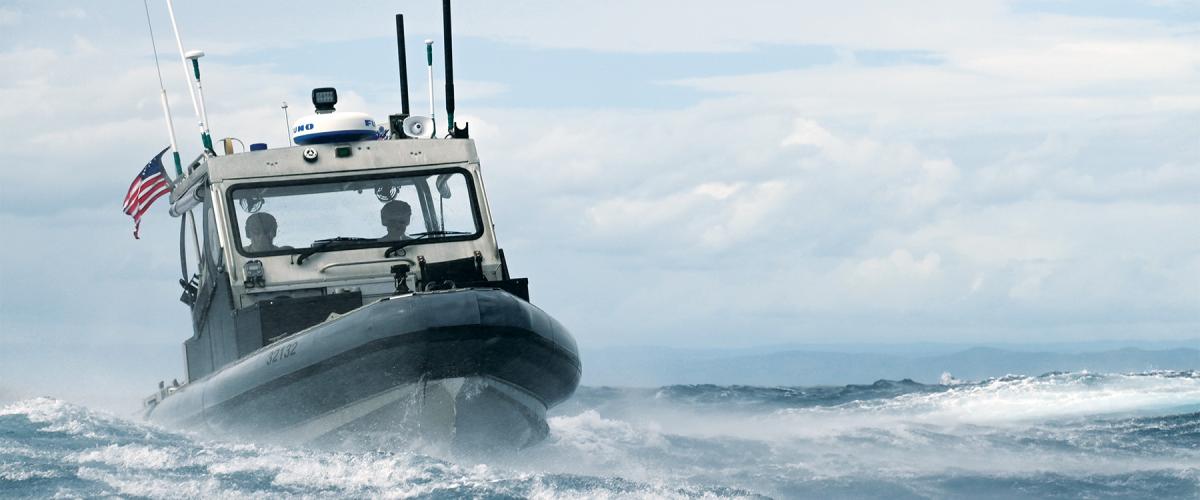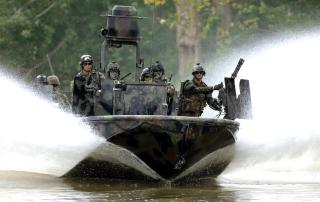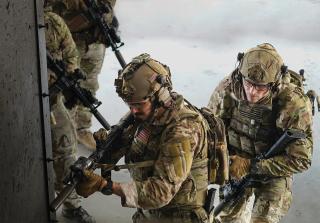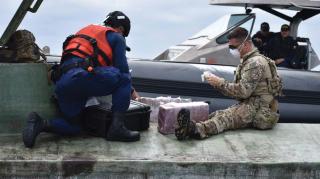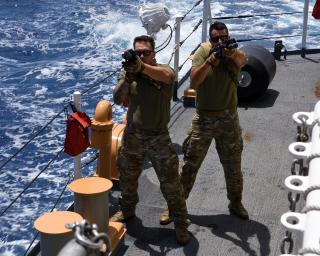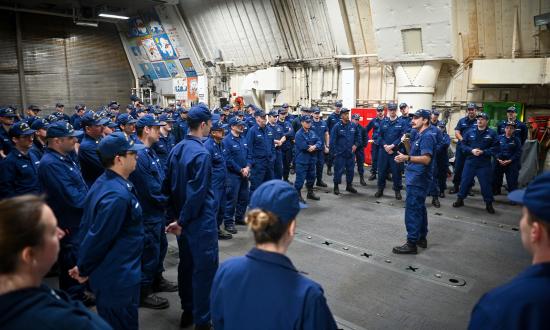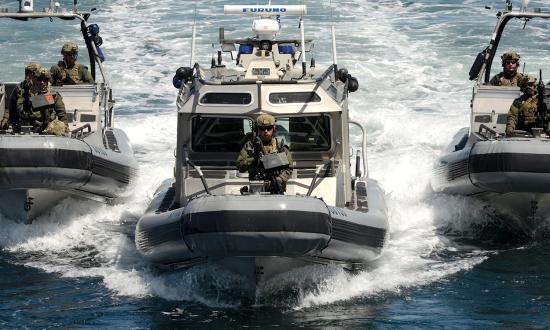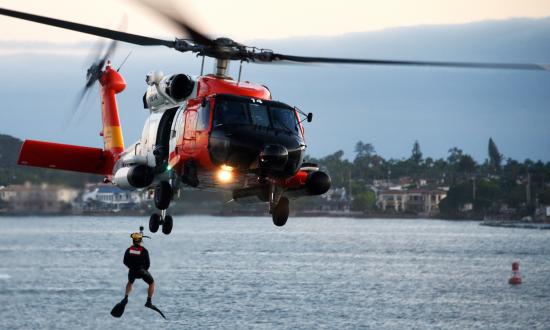The Coast Guard’s armed deployable specialized forces (DSF) are the nation’s experts on maritime counterterrorism, counterdrug, and counterpiracy operations. Since 1982, Coast Guard tactical operators have conducted these missions on board U.S. Navy, allied, and partner nation surface assets across the globe.1 Consisting of three active-duty unit types and a complement of reserve port security units (PSUs), the armed DSF are a globally deployable community of highly trained and specialized personnel. DSF also includes units without firearms or weapons capability, such as the National Strike Force that responds to national disasters and major incidents, and regional dive lockers executing the Coast Guard’s subsurface missions. Between law enforcement detachments (LEDets), which belong to one of two parent units called tactical law enforcement teams (TacLETs), ten maritime safety and security teams (MSSTs), and two maritime security Response teams (MSRTs), recent DSF successes include several multimillion-dollar drug interdictions and seizure of massive weapons caches in the Arabian Sea.2
Despite these achievements, DSF face significant setbacks because of its placement within the Coast Guard’s Response-Ashore mission area instead of being their own community. The Coast Guard needs to dedicate a career path for DSF officers and enlisted personnel and remove self-imposed barriers to DSF personnel development by mirroring the program to that of Naval Special Warfare (NSW).
Specialized, Not Special
Jobs that require specialized capabilities inherently require continued maintenance of those skills. In the Coast Guard, armed DSF units provide specialized and nonredundant capabilities in the form of close-quarters combat, small-team global deployment, and noncompliant or hostile-force opposed vessel boarding techniques, such as fast-roping, hook and climb, and no-notice boardings of vessels assessed to be of increased risk to a boarding team.3 No other units in the Coast Guard are authorized to conduct these missions.
As part of a maritime service with similar capabilities, mission requirements, and operating environment, the armed DSF career path for officer and enlisted service members should mirror that of NSW. According to the Coast Guard’s Response Ashore Junior Officer Career Guide, officers who have been assigned to DSF units are considered response officers and thus must follow the prescribed career path that includes pollution Response, search and rescue (SAR), emergency management, and maritime law enforcement.4 This career path culminates in achieving SAR experience in the form of qualifications and time spent assigned to U.S. Coast Guard sector, district, or area command centers where SAR is the highest priority mission.
As expected, this path consumes an enormous amount of energy, resources, and time. For DSF operators, it takes one to two years to fully qualify (based on personal experience and observations) in their assigned positions, and tour lengths of just three to four years leave little time for DSF officers to fully develop as specialists and leaders within the community, especially when alternating with “traditional” Response-Ashore assignments. Although listed as a Response “subspecialty” under the Coast Guard’s Officer Specialty Management System (OSMS), DSF tours are not essential to career development.
Furthermore, DSF officers are limited to one operational tour during which they lead teams conducting operational missions.5 Opportunities exist later as command cadre and in staff assignments, but these billets are sandwiched by tours outside DSF, often in afloat billets or in other Response-Ashore positions with little to no involvement with DSF. In contrast, NSW officer career progression has little deviation outside of NSW, with multiple follow-on tours at the various units falling under the administration of the Naval Special Warfare groups (NSWGs).6
A Diluted Skillset
As officers rotate out of their DSF billets, the knowledge and experience they gained during that time is lost. While they can impart that knowledge to their subordinates once in a position of higher leadership at a DSF unit later in their careers, this opportunity might be six to ten years later or more—or might not happen at all. It is inefficient to continue training new personnel year after year only to lose those costly skills when tours of duty finish.
Because DSF falls under the Response community, the retention and maintenance of acquired knowledge in both areas of expertise are diluted by each other. Specifically, the SAR mission area of Response is the greatest obstacle and achievement for DSF-centric officers and Response officers, respectively.
The Coast Guard’s OSMS is used to track officer career paths and assist with goal setting based on the needs of the service’s mission areas. Advancing through the levels of apprentice, journeyman, and master within the OSMS specialties and subspecialties requires time in billet, experience, qualification, and competency gained throughout all available mission and support communities. The Response specialty affords the opportunity to earn subspecialties in all Response mission areas including DSF; however, advancement to journeyman within this community—a necessary step for promotion—is bottlenecked by the requirement for a sole subspecialty: SAR.
Essentially, all Response officers, regardless of background or skills, are required to achieve SAR qualifications. Imagine if Navy SEALs, one of the most lethal fighting forces in the world, rotated out of their specialized areas to support Navy units outside of NSW missions. While DSF are not NSW in terms of history, authority, and some specific skills, the parallels are apparent.
This argument can extend to other subspecialties of the Response community as well; however, the requirement for DSF officers to shift priorities between two separate mission areas (DSF and SAR) creates officers who must split their time and knowledge between both, effectively limiting their potential to excel in each subspecialty. Moreover, while many DSF officers long for experiences that compare to their time at MSSTs, TacLETs, and MSRTs, they are met with statements indicating that it will never happen again. In an age in which members are seeking greater financial and geographic stability, job satisfaction is one of the last remaining barriers to personnel separating from the service.7 If retention of qualified personnel truly is a service-wide epidemic, then ensuring continuous job satisfaction in conjunction with skill continuity among motivated people within DSF and other communities should be a priority.
Self-Made Barriers to a Stand-Alone DSF Community
DSF officers are commonly told that leadership opportunities are limited at the O-4, O-5, and O-6 levels with DSF divided between operational and support units. Between TacLET and MSRT, there are two O-6 positions and six O-5 positions. Each of the 10 MSSTs is commanded by an O-4, with four additional O-4 billets at TacLET and MSRT.8 This billet structure compares to NSW, which boasts an active-duty workforce of 5,400, more than four times as large as the Coast Guard’s armed DSF complement of 1,261 personnel in 2019.9
NSW has only 12 senior officer positions to lead a force of 5,400, whereas DSF has 8 senior officers for a force of 1,261. Therefore, the argument that there are not enough leadership billets to keep DSF separate is unfounded. There is room for career progression and professional growth within DSF.
Following NSW’s lead, the way to identify those who will be successful is through selection and assessment. DSF personnel are required to be critical thinkers, problem solvers, and innovative operators who must continually strive for mastery of tradecraft to stay ahead of emerging threats and developing adversary tactics. Comparable to the expectations for NSW operators, these standards can be met by identifying, enrolling, assessing, selecting, training, and developing those who will ensure mission success in the future.10
Furthermore, enlisted rates assigned to armed DSF units are expected to alternate between MSRTs and TacLETs upon receiving their “tactical operator” designation. However, the “needs of the service” often violate this when qualified members are sent elsewhere to fill gaps that do not require the specialized skills of DSF. In 2010, it was found that the DSF precursor, the deployable operations group, had been facing challenges already regarding the selection of candidates and their ability to qualify and maintain high-risk capabilities.11 A selection and assessment of Coast Guard tactical operators would ensure a DSF workforce that is capable, willing, and committed to ensuring mission success and instilling confidence in DSF units while performing their assigned missions.
Recommendations
By mirroring the NSW career progression, including selection and assessment of tactical operators, the Coast Guard can build a specialized community with unique, effective, and adaptable skills to support the national security strategy and global security initiatives. While armed DSF are split among MSRTs, TacLETs, and MSSTs, the capabilities across these three units match those of NSW relative to the operational needs of the service. Tactical operators who compose a direct-action section are akin to SEAL platoons conducting similar missions; precision marksman observer teams are the Coast Guard’s snipers; and the tactical delivery teams delivering an assault force onto a target are the equivalent of NSW’s special warfare combatant craft.12 The final step is promulgating officer and enlisted career path guidance that focuses on obtaining and maintaining DSF skills for the entirety of their time in service, not just for one or two assignments.
Coast Guard DSF operators can be found on the front lines of national security, counterterrorism, and countersmuggling operations. By removing the barriers limiting these operators from becoming masters of their craft, the Coast Guard can create a community that leads the nation’s maritime services as instruments of global national power.
1. Michael Shelton, “The Forward Edge of Drug Interdiction,” Navy League of the United States, September 2001.
2. U.S. Coast Guard Human Resources, CG-11, “Deployable Special Forces”; U.S. Naval Forces Southern Command, “USS Milwaukee Seizes $22 Million in Suspected Cocaine,” 19 January 2022; “U.S. Navy Seizes Giant Weapons Cache from Smugglers in Arabian Sea,” The Maritime Executive, 22 December 2021; and Brad Lendon, “The Weapons Seizure So Big It Covered the Rear Deck of a 567-foot Warship,” CNN, 10 May 2021.
3. Matthew Masaschi, “Coast Guard Maritime Security Response Team West Service Members Conduct Fast Rope Demonstration during San Francisco 2019 Fleet Week,” DIVIDS, 11 October 2019.
4. U.S. Coast Guard, Operations Ashore Junior Officer Career Guide, June 2015.
5. U.S. Coast Guard, Operations Ashore Junior Officer Career Guide.
6. U.S. Coast Guard, “FY-22 Active-Duty Line Community Brief,” MyNavyHR.
7. U.S. Coast Guard, Ready Workforce 2030, April 2022.
8. U.S. Coast Guard, Operations Ashore Junior Officer Career Guide.
9. “NSW Structure,” NavySeals.com; and U.S. Government Accountability Office, Coast Guard: Assessing Deployable Specialized Forces’ Workforce Needs Could Improve Efficiency and Reduce Potential Overlap or Gaps in Capabilities (Washington, DC: GAO, November 2019).
10. RADM H. W. Howard III, USN, “Frogmen Solve Hard Problems—From and on the Sea,” U.S. Naval Institute Proceedings 148, no. 4 (April 2022).
11. U.S. Government Accountability Office, Coast Guard: Assessing Deployable Specialized Forces’ Workforce.
12. PO2 Jetta DiscoSmall, USCG, “MSRT: Coast Guard’s Specialized Forces to Be Reckoned With,” Coast Guard News, 21 April 2014; and Travis Allen, “MSRT: The U.S. Coast Guard’s Full Time Counterterror Team,” SOFREP, 14 February 2017.



